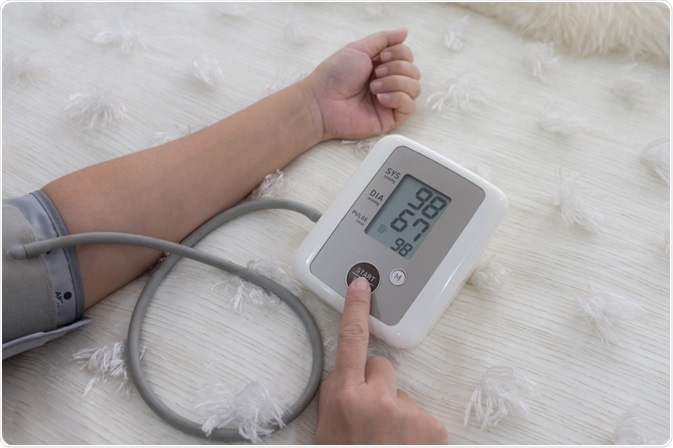Low blood pressure, otherwise known as hypotension, is a condition characterized by abnormally low pressure in the blood vessels. A fall in arterial blood pressure can result in failure to adequately perfuse the systemic capillary networks. Different conditions and syndromes can result in hypotension.

Image Credit: Voraorn Ratanakorn / Shutterstock.com
Orthostatic hypotension
Orthostatic hypotension is defined as a sustained reduction of systolic blood pressure of 20 mmHg or diastolic blood pressure of 10 mmHg within three minutes of standing or head-up tilt (more than 60 degrees). The condition, which is also known as postural hypotension, is not life-threatening but can be associated with significant morbidity.
A normal function of the cardiovascular and autonomic nervous systems is required in order to achieve a normal hemodynamic response to changes in posture. Orthostatic hypotension may arise as a result of inadequate intravascular volume, decreased return of venous blood, autonomic nervous system dysfunction, or an inability to increase cardiac output in response to postural changes.
Orthostatic hypotension can be acute or chronic in nature, as well as symptomatic or asymptomatic. The symptoms that occur are likely due to cerebral hypoperfusion secondary to systemic hypotension. The condition is also associated with an increased incidence of cerebrovascular disease, coronary heart disease, cardiovascular mortality, and falls.
Postprandial hypotension
Postprandial hypotension is a reduction in blood pressure after a substantial meal. This form of hypotension represents a prevalent condition in the elderly population and appears to be a common cause of syncope and falls in hypertensive and frail elderly individuals. Still, the exact relationship between symptoms and postprandial reductions in blood pressure is unclear.
The epidemiology and pathophysiology of postprandial hypotension are not defined fully, and treatment approaches are largely based on anecdotal observations. However, a number of pathologic processes are likely involved, including abnormal sympathetic function, baroreceptor function, as well as vasoactive peptide release and activity.
The current definition of postprandial hypotension uses a threshold of 20 mm Hg as a cut-off for diagnosis, but this may not be relevant to the presence or absence of symptoms. Typically, a postprandial hypotension episode will occur within two hours of a meal. Furthermore, the magnitude of a postprandial fall in blood pressure is dependent on meal composition. Ingestion of carbohydrates, glucose in particular, has the greatest effect.
Other syndromes
A myriad of neurologic disorders including multiple sclerosis, spinal cord injury, and tabes dorsalis (syphilitic myelopathy), can cause autonomic dysfunction and result in symptomatic hypotension. Heightened baroreceptor response to afferent stimuli and enhanced efferent parasympathetic activity also lead to hypotension.
Shy-Drager syndrome represents a rare degenerative disorder of the sympathetic and basal ganglia that results in autonomic nervous system dysfunction and orthostatic hypotension. This condition is also called multiple system atrophy and shares many Parkinson's disease-like symptoms.
Neurocardiogenic syncope is the most common type of syncope characterized by an acute decrease in systemic arterial blood pressure and cerebral blood flow, resulting in a sudden loss of consciousness and postural tone. This form of syncope may be triggered by orthostatic stress, particularly in warm environments, pain or emotional stress, low hydration, and prolonged fasting.
References
Further Reading